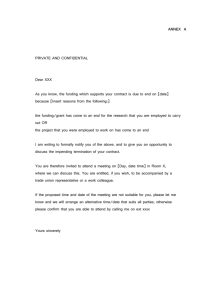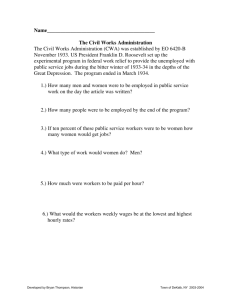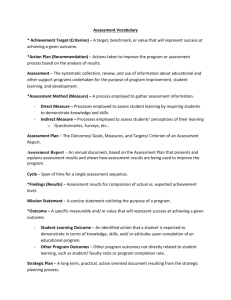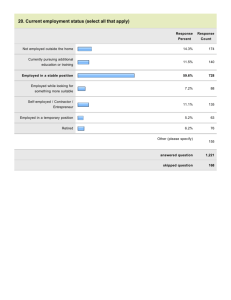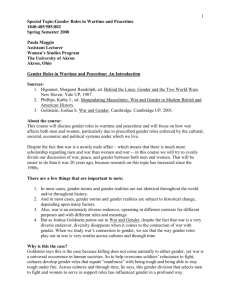E m p l o y m e n t ... Chapter 9
advertisement
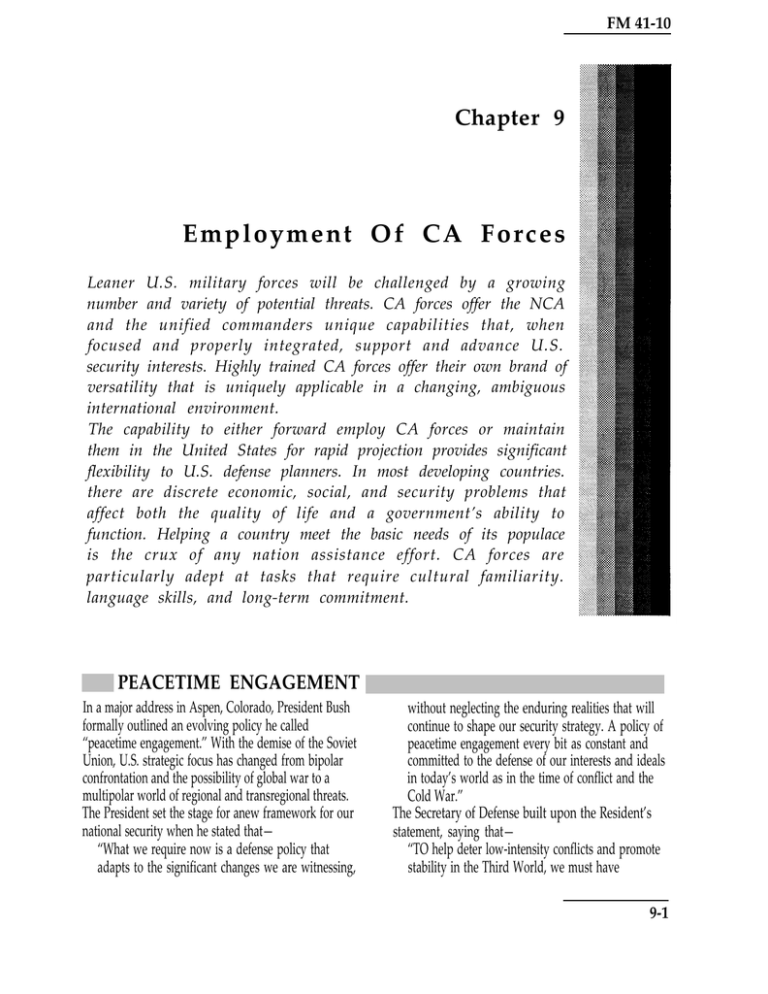
FM 41-10 Chapter 9 Employment Of CA Forces Leaner U.S. military forces will be challenged by a growing number and variety of potential threats. CA forces offer the NCA and the unified commanders unique capabilities that, when focused and properly integrated, support and advance U.S. security interests. Highly trained CA forces offer their own brand of versatility that is uniquely applicable in a changing, ambiguous international environment. The capability to either forward employ CA forces or maintain them in the United States for rapid projection provides significant flexibility to U.S. defense planners. In most developing countries. there are discrete economic, social, and security problems that affect both the quality of life and a government’s ability to function. Helping a country meet the basic needs of its populace is the crux of any nation assistance effort. CA forces are particularly adept at tasks that require cultural familiarity. language skills, and long-term commitment. PEACETIME ENGAGEMENT In a major address in Aspen, Colorado, President Bush formally outlined an evolving policy he called “peacetime engagement.” With the demise of the Soviet Union, U.S. strategic focus has changed from bipolar confrontation and the possibility of global war to a multipolar world of regional and transregional threats. The President set the stage for anew framework for our national security when he stated that— “What we require now is a defense policy that adapts to the significant changes we are witnessing, without neglecting the enduring realities that will continue to shape our security strategy. A policy of peacetime engagement every bit as constant and committed to the defense of our interests and ideals in today’s world as in the time of conflict and the Cold War.” The Secretary of Defense built upon the Resident’s statement, saying that— “TO help deter low-intensity conflicts and promote stability in the Third World, we must have 9-1 FM 41-10 innovative strategies that support representative government, integrate security assistance, and promote economic development. Our approach for doing this is peacetime engagement—a coordinated combination of political, economic, and military actions, aimed primarily at counteracting local violence and promoting nation-building.” Peacetime engagement reflects a shift from global to regional crisis management. It puts a premium on regional politico-military problem solving and operations short of war. Successful implementation of peacetime engagement requires the United States to be proficient in four security mission areas. These areas are— Diplomacy and its support. Precrisis activities. Force projection and crisis response. Postcrisis activities. CA forces are particularly well suited to implement such a policy. They have clearly demonstrated the capability to respond effectively to short-notice contingencies and have shown they can conduct the wide range of actions required to— Deter regional conflict. Combat terrorism, insurgences, and drug trafficking. Promote nation-building. CA forces have proven themselves equal to the task in Panama, Kuwait, and Bangladesh and in developing nations worldwide. Considering peacetime engagement requirements in the future, the opportunities for employing CA forces are great. CA VERSATILITY CA forces are versatile, ready, and uniquely capable of operating in all politico-military environments. They can be used in— Training during peace. FID and nation assistance operations requested by allies and international partners. Full-blown conventional warfare. CA forces are forward employed from the grassroots level—where the problems art-to the ambassadorial level, providing advice and assistance and coordinating requirements. For example, CA forces provide assistance and training to FN forces and officials, when requested, by— Assisting doctors and medical officials in disease prevention and child health care. In peace, CA forces can be used as instruments of national policy. They can be used to help promote international stability, foster economic and political pluralism, and reduce conditions that create human misery and fuel insurgences. They can be employed in a variety of roles where political constraints restrict the use of high-visibility GP forces. In conflict situations, CA forces area combat multiplier that, when integrated with GP forces, maximize force potential and capability. Caring for and feeding DCs. Supporting the CD fight. Assisting HN FID activities through military to military training programs. Integrating with GP forces engineer units and HN forces to build schools, roads, and medical facilities. EMPLOYMENT RELATIONSHIP CA units are an essential part of the total Army concept and provide critical CS and CSS across the operational continuum. The criteria for employing CA include the basic one-word questions found in Figure 9-1, page 9-3. CA units are CAPSTONE aligned and regionally oriented. A particular CA unit may focus on several 9-2 different countries within its region. The various environments in each country may span the operational continuum. For example, CA forces may support conventional operations in a country at war. They may at the same time support HA in bordering countries and assist in FID in another country. FM 41-10 9-3 FM 41-10 CA forces may be employed in part or in whole. CA commanders can task organize their units at the lowest level. This ability allows CA commanders to concentrate specific CA capabilities in support of specific problems as well as maintaining support of the overall operation. CA units may be employed in DS of specific supported units or in GS of several supported units. CA 9-4 relationships to supported units provide overlapping CA support as required during operations. CA units in a DS role provide general CA (generalist) support while retaining the organic capability to provide direct CA (specialist) support in a GS role. For example, a CA unit in direct support of a division task organizes to provide CA generalists to each divisional brigade in a DS role and to provide CA specialists to all the divisional brigades in a GS role (Figure 9-2). FM 41-10 EMPLOYMENT OF RESERVE COMPONENT CA FORCES The greatest contributing factor to CA capabilities is the inherent civilian occupational skills acquired through the RC. CA forces are primarily in the RC for this reason. The authority to mobilize RC forces for military operations lies with the President. The mobilization of whole RC CA units in the past has been during preparation of war only. However, CA units train for all environments. One of the greatest obstacles to RC CA employment is that RC CA units normally do not mobilize during peace. To overcome this obstacle, RC CA units deploy CA teams for short-term operations. They can rotate these teams to overcome other obstacles such as providing CA support to long-term projects. In the past, RC CA forces were employed during short-term contingency operations on a volunteer basis. Individuals having a specific civilian occupational skill were selected for short-term active duty tours as needed. EMPLOYMENT OF ACTIVE COMPONENT CA FORCES AC CA forces are forward employed worldwide maintaining the effective mix with their corresponding RC structure. As RC CA teams rotate during long-term projects, forward employed AC CA forces maintain the rapport with their respective FN, U.S., and outside agency counterparts. They can maintain sustainment and depth during CA operations. AC CA forces can be rapidly projected to support the first U.S. forces to arrive during all U.S. military operations. These AC CA forces can then be sustained by follow-on RC CA forces. FUTURE EMPLOYMENT In a television interview following operation Desert Storm, General Colin Powell reported there had been twelve crises during his tenure as CJCS. He added, “I don’t know what the next crisis will be, but it will probably be humanitarian assistance.” His prediction came true with a coup in Haiti when hundreds of Haitian refugees attempted to emigrate. Again, U.S. CA units were task organized and deployed immediately to Guantanamo Bay, Cuba. Whatever the next crisis, CA forces used for planning and supporting U.S. military operations can avoid repeating mistakes of the past. When given an operational mission, military commanders must challenge their supporting CA units to enhance the military effort and promote legitimacy of the military mission. 9-5
